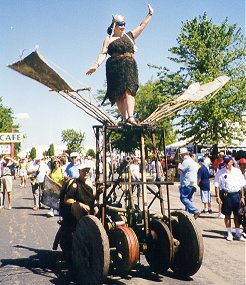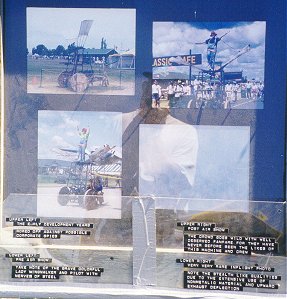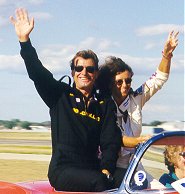Navigate this Site:

 Home
Home

 Racing
Racing

 Nissan Destruction
Nissan Destruction

 Aviation
Aviation


 FAA Database
FAA Database


 Oshkosh Home
Oshkosh Home



 July 26
July 26



 July 27
July 27



 July 28
July 28



 July 29
July 29



 July 30
July 30



 July 31
July 31



 August 1
August 1



 August 2
August 2



 August 3
August 3



 Final Thoughts
Final Thoughts



 Email
Email


 Fort Simpson Trip
Fort Simpson Trip

 MP3 Music
MP3 Music

 Nero's Cancer
Nero's Cancer

 LiveJournal Images
LiveJournal Images

 Treo 650 Software
Treo 650 Software

 Dr. Fun Archive
Dr. Fun Archive

 Freethinkers
Freethinkers
|
Oshkosh
1998: Day 5
Thursday, July 30
Not willing to attempt Hardees again, we once again reverted to oatmeal for breakfast. Once again, perfect weather - even though we had a spat of rain overnight, we've had nothing but sunshine and perfect weather for the entire convention - something which persisted throughout our entire stay in Wisconsin.
We decided this morning to go visit the ultralight section of Oshkosh. The airport is very large - and not wanting to walk the the three miles from our campsite (at the northernmost end of the field) to the ultralights (at the southernmost end of the field), we took several of the tractor-towed trams which run all day. These trams are usually crammed full of people (as the buses are), but we managed to find a spot to sit down.
As we arrived in the ultralight section, they were just beginning a demonstration of various homebuilt helicopters. We watched a Rotorway Exec helicopter as well as a Mini-500. I don't think you could pay me to go up in one of those Mini-500's. They may have their uses, but they seem just a little flimsy to me. When it was idling on the ground, the tail boom was shaking considerably - a stress fracture just waiting to happen. I have some stick time in helicopters, I know how they work, I know what makes them fly, and I also know what can go wrong. There are so many tiny little things that can go wrong in helicopters which will cause you to fall out of the sky like a rock, that I prefer not to fly in them. In any case, all the helicopters we saw seemed to fly quite well, without problems. They certainly have their purpose in the world, just don't ask me to ride in one.
 One of the more
interesting, uh, aircraft that we saw in the ultralight area was the "Orbit."
This strange looking thing consisted of a steel tube frame with fabric stretched over it
in the shape of an inclined circle, with a large tail and rudder, and small ailerons
inside the circle, all driven by a pusher prop. The pilot operated it by standing on some
footpegs attached to the nosewheel, and hanging in place by a D-ring attached to the upper
tubing. A sign in front of this contraption stated: "Orbit. Answers: Yes it does. Not
very well. Not very high. Testing ongoing."
One of the more
interesting, uh, aircraft that we saw in the ultralight area was the "Orbit."
This strange looking thing consisted of a steel tube frame with fabric stretched over it
in the shape of an inclined circle, with a large tail and rudder, and small ailerons
inside the circle, all driven by a pusher prop. The pilot operated it by standing on some
footpegs attached to the nosewheel, and hanging in place by a D-ring attached to the upper
tubing. A sign in front of this contraption stated: "Orbit. Answers: Yes it does. Not
very well. Not very high. Testing ongoing."
 Back in the main area again, I was attracted by the wildly flailing
wings of a contraption known as the "Ornithopter." This tongue-in-cheek vehicle
was made of wooden logs, an old single cylinder engine running at about 250 rpm, and a
series of wooden levers, cogs, and such. A set of pictures nearby showed off the
Ornithopter's capabilities. While we were looking at this, uh, device, the
"pilot" got on the vehicle and told us he was going to give us a demonstration
of its abilities.
Back in the main area again, I was attracted by the wildly flailing
wings of a contraption known as the "Ornithopter." This tongue-in-cheek vehicle
was made of wooden logs, an old single cylinder engine running at about 250 rpm, and a
series of wooden levers, cogs, and such. A set of pictures nearby showed off the
Ornithopter's capabilities. While we were looking at this, uh, device, the
"pilot" got on the vehicle and told us he was going to give us a demonstration
of its abilities.  He
said that he would give us a small "hover" demonstration, and with great
fanfare, revved up the engine to redline (about 1000 rpm) and pulled a lever. With slight
assistance from an engine-powered car jack on the bottom of the thing, the Ornithopter's
leather-covered wings pulled the vehicle into the air for a (very brief) hover, and then
came crashing back down to the ground.
He
said that he would give us a small "hover" demonstration, and with great
fanfare, revved up the engine to redline (about 1000 rpm) and pulled a lever. With slight
assistance from an engine-powered car jack on the bottom of the thing, the Ornithopter's
leather-covered wings pulled the vehicle into the air for a (very brief) hover, and then
came crashing back down to the ground.
We later saw this same aircraft taxiing around the convention grounds, with none other than a wing walker on top. Amazing that it can cruise at such an altitude with all that parasite drag. We did go into the tent next to the Ornithopter, where its inventors showed us four operational replica engines that they had constructed. the first one was an actual working copy of the engine used on the Wright flyer, and they started it up and ran it for a minute. The next was an improved version, still four cylinders, but incredibly loud. The third was a Gnome rotary engine, which I had never seen in operation before. The last one was again a conventional four cylinder engine, with a propeller in place.
After seeing the ultralights, we headed towards two of the four large hangars, which contained hundreds of exhibits and booths. I was looking for a couple things in particular: A retrofit ANR (active noise reduction) kit for my aviation headset, and some flight planning software. I found both: The ANR kit came from Headsets, Inc, and cost $169 at the show. I installed this kit in my David Clark H10-20's when we got home (about one hour's work), and it works spectacularly well - I'm very impressed. The software was Destination Direct, and I took advantage of a show special there as well, getting $20 off regular list price. I also picked up a free CD containing weather graphics software for use with GTE DUATS.
After the hangars, we headed over to the "fly market", aviation's equivalent of the "flea market." In this large section, you will find everything from dusty old propellers to assorted engine parts to kitchen knives. While heading over to the fly market, a man and his wife came from one of the exhibits and said, "whew, we've seen it all." The husband then saw the enormous fly market, and said, "oh no we haven't, there's more down there." I said to him, "actually, that's the fly market, not exhibits." His wife, who had been looking a bit more than uninterested suddenly perked up. "Flea market!?!" she exclaimed. "Let's go!!", pulling him after her.
 The highlight of Thursday's airshow was Patty Wagstaff and Sean D.
Tucker
The highlight of Thursday's airshow was Patty Wagstaff and Sean D.
Tucker  flying
together in a somewhat quickly improvised routine. The routine showed the differences
between their flying styles - Sean does a lot of "barnstormer" type maneuvers,
tumbling and spinning, trailing smoke. Patty on the other hand is all precision and
sharpness. Her turns, snap rolls, loops and other moves are precise and accurate. These
two pilots are really two of the best airshow pilots in the world, and to see their
different styles of flying side by side was really a treat. They do this combined routine
only a few times a year, when they happen to be performing at the same airshow. They put
it on as a "contest" between the two, and the announcers played along, trying to
keep score and keeping up a friendly banter. Great entertainment!
flying
together in a somewhat quickly improvised routine. The routine showed the differences
between their flying styles - Sean does a lot of "barnstormer" type maneuvers,
tumbling and spinning, trailing smoke. Patty on the other hand is all precision and
sharpness. Her turns, snap rolls, loops and other moves are precise and accurate. These
two pilots are really two of the best airshow pilots in the world, and to see their
different styles of flying side by side was really a treat. They do this combined routine
only a few times a year, when they happen to be performing at the same airshow. They put
it on as a "contest" between the two, and the announcers played along, trying to
keep score and keeping up a friendly banter. Great entertainment!
Thursday's dinner was a bit dire, consisting of some canned spaghetti. The "cooking out on the campstove" routine was wearing a bit thin. We might eat out tomorrow instead...
This page copyright � 1998